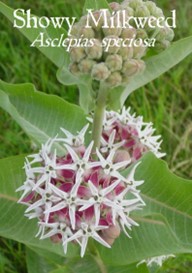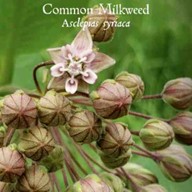|
There's plenty of folklore associated with this wonderful Moon plant, probably because of the sheer magicalness of its fluff. It is said that adding milkweed fluff to dream pillows will make one dream of the Fae. Folklore also says that for each floating seed one catches and lets go of, a wish is granted. The flowers are associated with Summer Solstice magick and the fluff with fall equinox. Some sources of magickal lore recommend using the juice of this magick herb to anoint a baby's third eye to enhance its imagination and creativity, but milkweed latex can cause itchy dermatitis even on adult skin. Stroking the area with a leaf tip might be a better idea skin-wise. Iroquois Indians used this plant to prepare themselves to fight witches, so it obviously has protective properties as well as being useful in divination. Its easily spun fibers offer unique opportunities for knot magic.
 Showy milkweed is one of the least toxic of the milkweeds--you can find recipes for the young leaves and seed pods--but please approach it with respect and care as other members of this family can be harmful if ingested. According to the University of North Carolina, rose milkweed is toxic only if large quantities are eaten; however, it is deadly to sheep. Plants for a Future reports that parts of it are edible by humans--the buds are cooked and said to taste like peas. They can also be dried and stored like peas. The shoots are cooked as a substitute for asparagus in two changes of water. The young seed pods are also said to be edible when they are little--about an inch/3-4 cm long--and cooked in two changes of water. Keep in mind that part of the reason why caterpillers like to eat this plant is because the plant's poison makes them taste bad to birds. If it tastes bitter, spit it out. Most interesting, the flowers can be boiled in water and reduced to a sweet syrup. This syrup might have interesting properties for incense making. Top Showy milkweed is one of the least toxic of the milkweeds--you can find recipes for the young leaves and seed pods--but please approach it with respect and care as other members of this family can be harmful if ingested. According to the University of North Carolina, rose milkweed is toxic only if large quantities are eaten; however, it is deadly to sheep. Plants for a Future reports that parts of it are edible by humans--the buds are cooked and said to taste like peas. They can also be dried and stored like peas. The shoots are cooked as a substitute for asparagus in two changes of water. The young seed pods are also said to be edible when they are little--about an inch/3-4 cm long--and cooked in two changes of water. Keep in mind that part of the reason why caterpillers like to eat this plant is because the plant's poison makes them taste bad to birds. If it tastes bitter, spit it out. Most interesting, the flowers can be boiled in water and reduced to a sweet syrup. This syrup might have interesting properties for incense making. TopHow to grow milkweed: Seeds should germinate easily at room temperature (68F/20C), but you will get a higher germination rate if you sow them in a paper towel that has been wet and wrung out, put in a baggie, and refrigerated for 4 weeks. Or sow on Winter Solstice (see special directions on the Solstice Sowing page). After hardening off (getting them used to sunlight slowly, 30 minutes per day), transplant seedlings to full sun. Asclepias incarnata likes Moon environments such as wet meadows, ditches, and the banks of ponds, but it will grow happily in regular garden conditions as well. It is a good plant for mucky clay and is deerproof. The flowers are 3-5"/8-12 cm wide and appear July-August. It is a perennial in temperate zones (3-9, or down to -40F/-40C). At 4 ft/1.2 m tall and 2 ft/50 cm wide, rose milkweed gets larger than regular and showy milkweed. Asclepias speciosa is perennial in zones 3-7, native to the western half of North America, and thrives in montanes, dry slopes, open woodland areas, and roadsides. Typically 1.5-3 ft tall (.5-1 m), it can reach 6 ft (1.8 m) in favorable conditions. Speciosa, like all milkweeds, is a specific monarch butterfly food and habitat plant. It is also the larval host for the dogbane tiger moth and the queen butterfly.  Asclepias syriaca is perennial in zones 4-9, native to the eastern half of North America, from New Brunswick, Canada, south to Georgia and west through Tennessee to Kansas and Iowa. This variety needs lots of sunlight and is often found in old fields, roadsides, and other liminal "waste places". It prefers medium to sandy or rocky soil. Typically 3-5 ft tall (1-1.5 m), it can reach 8 ft (2.4m) in ditches and gardens. Native Americans used common milkweed for fibers, and even today the floss (white fluff attached to the seeds) is harvested for use in pillows.
Aphids tend to like milkweed stems, so if you see them, spray them
off with a strong stream of water. General growing info. Top Asclepias syriaca is perennial in zones 4-9, native to the eastern half of North America, from New Brunswick, Canada, south to Georgia and west through Tennessee to Kansas and Iowa. This variety needs lots of sunlight and is often found in old fields, roadsides, and other liminal "waste places". It prefers medium to sandy or rocky soil. Typically 3-5 ft tall (1-1.5 m), it can reach 8 ft (2.4m) in ditches and gardens. Native Americans used common milkweed for fibers, and even today the floss (white fluff attached to the seeds) is harvested for use in pillows.
Aphids tend to like milkweed stems, so if you see them, spray them
off with a strong stream of water. General growing info. Top
|
Asclepias incarnata Showy milkweed 40 seeds $3.50 Asclepias syriaca Common milkweed 40 seeds $3.50
Uses in Witchcraft & Magic:
Fairy Plant © 2006-2024 Alchemy Works; No reproduction of any
part without permission. |
Alchemy Works products are offered for use in spiritual, ritual, meditative, and magical practices, not for medicinal or cosmetic purposes. The information on this website is provided for its folkloric, historic, and magical value. It is not intended to be a substitute for professional medical advice, diagnosis, or treatment.